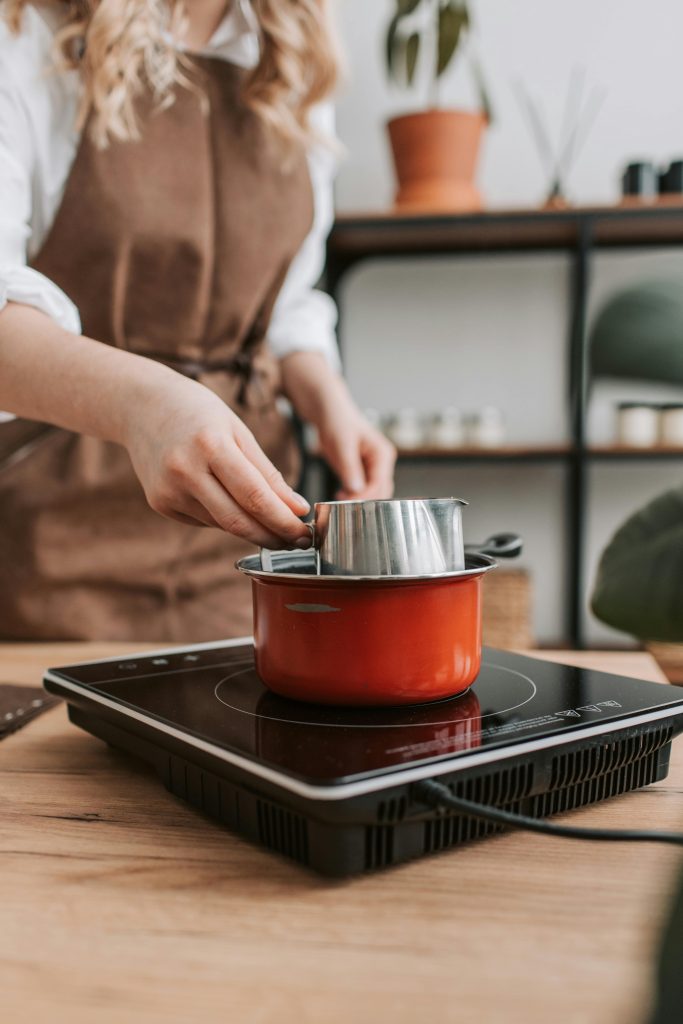
💡 What Is an Induction Cooktop?
Instead of flames or hot coils, induction cooktops use electromagnetic energy to heat your cookware directly. This means faster cooking, better energy efficiency, and a safer kitchen environment—all while preserving your food’s flavor and aroma.
⚙️ How Induction Cooking Works
Under the sleek glass-ceramic surface lies a coil that produces an alternating magnetic field. When you place a magnetic-bottom pot (like cast iron or induction-grade stainless steel) on it, eddy currents heat the cookware directly—bypassing the burner surface entirely. This results in instant and precise heating, without wasted energy.
🧪 Materials & Surface Design
Induction cooktops are built with:
- Glass‑ceramic flat surfaces—easy to clean, highly durable, and heat-resistant
- Seamless design—no hidden crevices where food can get trapped
- Modern aesthetics—sleek, minimal, and often with LED touch controls
📜 A Brief History
From a patent nearly 100 years ago to the first Frigidaire prototype in the 1950s, induction cooking has evolved steadily. It wasn’t until the 1980s, however, that affordable, mass-produced units made it into homes. Since then, they’ve continued gaining popularity for their performance and convenience.
⚡ Why Induction Is Faster & More Efficient
- Up to 40% faster cooking than electric or gas stoves
- 85–90% energy transfer directly to cookware
- LED zone indicators—no guessing where the heat is
- No combustion means no odor or flames
- Virtually silent operation and precise temperature control
- Safety features like auto shut-off and child lock
🧲 Cookware Compatibility
To work with induction, cookware must have a magnetic base:
Compatible materials:
- Cast iron
- Enameled cast iron
- Magnetic-grade stainless steel
Incompatible materials:
- Glass
- Copper (unless base is magnetic)
- Bare aluminum
Quick test: If a magnet sticks to the bottom, it’s a go.
✅ Key Benefits
- Safer: no open flame, cooktop stays cool
- Faster: quicker boiling and heating times
- Easy to clean: flat surface, no waits for cool-down
- Energy-efficient: reduced utility costs
- Smart: built-in timers, sensors, auto shut-off
- Sustainability: lower energy waste
❓ Frequently Asked Questions (FAQ)
Q: What is the main advantage of an induction cooktop?
A: Speed, precision, safety, and energy savings—resulting in an overall efficiency and cooking experience like no other.
Q: Can I use regular cookware on induction?
A: Only cookware with a magnetic base works—use cast iron, magnetic stainless steel, or test with a magnet.
Q: Is induction cooking child-safe?
A: Yes. Surfaces remain cool unless cookware is present, and many models include child locks and auto shut-off.
Q: How much energy do induction cooktops save?
A: Induction transfers up to 90% of electricity into heat, compared to about 70% for electric coils, saving both time and bill money.
Q: Are induction cooktops noisy?
A: They operate with minimal noise—mostly a soft hum from the cooling fan, far quieter than gas sizzling or flames.
🏁 Final Thoughts
An induction cooktop isn’t just a trend—it’s a transformation. If you’re building a new kitchen or upgrading your cooktop, induction offers superior speed, safety, and efficiency. With thoughtful cookware choices, it’s a clear upgrade over gas or traditional electric stoves.
Leave a Reply
You must be logged in to post a comment.